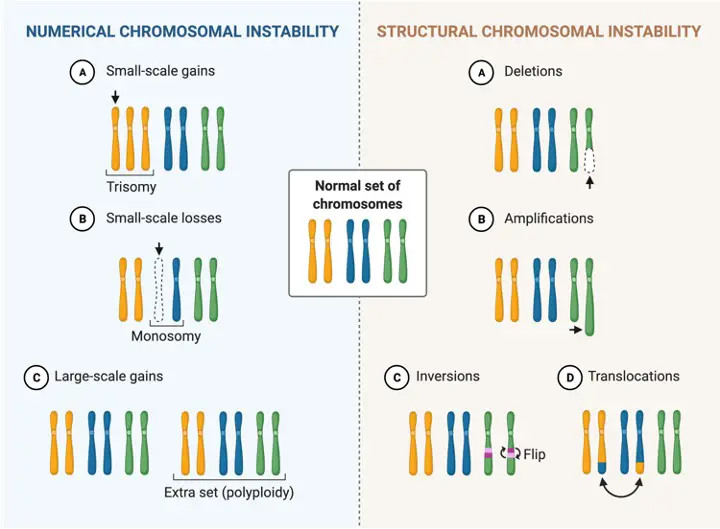Table of Contents
What is Diploid Cell?
The word diploid originates from a Greek word, which can be divided into two words, di meaning two and ploidy meaning the presence of two pairs of chromosome within a cell. Thus, the cells possessing two sets of chromosome, which are homologous is called as diploid. As there is two pair of chromosome, one pair is obtained from mother and the other one from father.
Chromosomes are nuclear material containing DNA, along with proteins. Chromosomes with genes or traits similar are known as homologous chromosomes. All the cells within the body of animals and plants are diploid, excluding the sex cells. The sex cell are haploid, with one pair of chromosomes.
The two haploid cell combines to form a zygote which is diploid. Within the human body, there exist two types of cell, sex cells and somatic cell. somatic cells are diploid and sex cells are haploid.
Ploidy: Haploid, Diploid and Polyploid
Ploidy represents the number of chromosomes set present within a cell. thus, on the basis of ploidy, cell can be classified into haploid, diploid and polyploidy. Cells with one set of chromosome are called as haploid, cells with two set of chromosomes are called as diploid and similarly triploid, tetraploid, pentaploid, hexaploidy and heptaploid and polyploid.

Cells with more than 3-4 pair of chromosomes are polyploid. For example, in silkworms, there are 10,48,576 ploidy. However, in human’s polyploidy is dangerous and if occurs results in termination of pregnancy.

Although polyploid conditions do exist, where there are either excess or less chromosomes. This is known as aneuploidy. An example is trisomy 21, where there exists 21 chromosomes, instead of 20. It is also known as Down’s syndrome.
Similar conditions are Patau syndrome also known as trisomy 13, Edwards syndrome known as trisomy 18. When a chromosome is absent it is known as monosomy. An example is Turners syndrome, where female lacks the X chromosome, or if present its defective.
In animals, which are quite developed polyploidy is not seen, but it does occur in plants. Example Solanum tuberosum. In animals its seen in viscacha rats and African frogs.
Humans have 23 pairs of chromosome, making a total of 46 chromosomes. Except the one set, all the chromosomes are diploid. Sex cells are haploid, which fuses to form a zygote which is diploid. Thus, 22 pairs are the somatic cells. Every sex cell contains 23 chromosomes, which combines with the other sex cell, making it 46. Thus, maintain the chromosome number constant, throughout.
As haploid cells in the beginning possess half number of chromosomes as that of diploid, they undergo meiosis, where half number of chromosomes is produced. When the two haploid cells fuses, they possess two pairs of chromosomes. This diploid cell will generate more diploid cells, through mitosis, forming a body.
The end-product of meiosis is 4 daughter cells, with half chromosome number. The end-product of mitosis is 2 daughter cells, with similar number of chromosomes. Examples of organism that are haploid are bees, wasp, ants and others.
Haploid cells contain one chromosome pair, undergo meiosis, whereas diploid cells undergo mitosis, as they have two pairs of chromosomes. Sex cells are haploid and somatic cells are diploid. Diploid cells resemble the parent, whereas haploids do not resemble due to crossing over. Example of diploids are muscle cell, skin cell. Example of haploids are sperms and eggs.
Diploid Cell Examples
Human sex cells (sperm or egg cells) contain 23 chromosomes in particular. This indicates that the diploid number of sperm and egg cells is half that of a human somatic cell (which is 46). The two cells join during fertilisation, creating a zygote with two sets of chromosomes. The human zygote then develops through the process of mitosis. As a result, the archetypal human chromosomal number of 46 per somatic cell in the body is preserved.
Plants have two generations in their life cycle: the gametophyte and the sporophyte. A gametophyte is a stage in the life cycle of a plant or the plant itself that carries gametes. As a result, a gametophyte, such as the embryophytes, is a haploid multicellular form of the plant. Virus are also diploid as they possess two sets of RNA.
Biological Importance of Diploid Cell
The number of mutations that occur within an individual can be determined by the ploidy level. Diploids contain two sets of chromosomes, thus contain more chances of getting mutated than haploid. Although mutation taking place within a cell also depends on the adaptation ability of organism and its thriving ability.
An organism which cannot thrive in adapting environment is more prone to mutation. Thus, diploids can better survive than haploids. Mutations occurring in haploids are said to shown effect immediately, whereas in diploid they are heterozygous. The retention of mutation is seen in haploids and not much in diploids.
When changes are due to selection, haploid organism are well developed, whereas when changes are managed by mutation, diploid organism are well trained for evolutionary changes.
Diploid Cell Citations
- Diploid sperm and the origin of triploidy. Hum Reprod . 2002 Jan;17(1):5-7.
- Physiological polyspermy: Selection of a sperm nucleus for the development of diploid genomes in amphibians. Mol Reprod Dev . 2020 Mar;87(3):358-369.
- Unzipping haplotypes in diploid and polyploid genomes. Comput Struct Biotechnol J . 2019 Dec 9;18:66-72.
- Figures are created with BioRender.com







